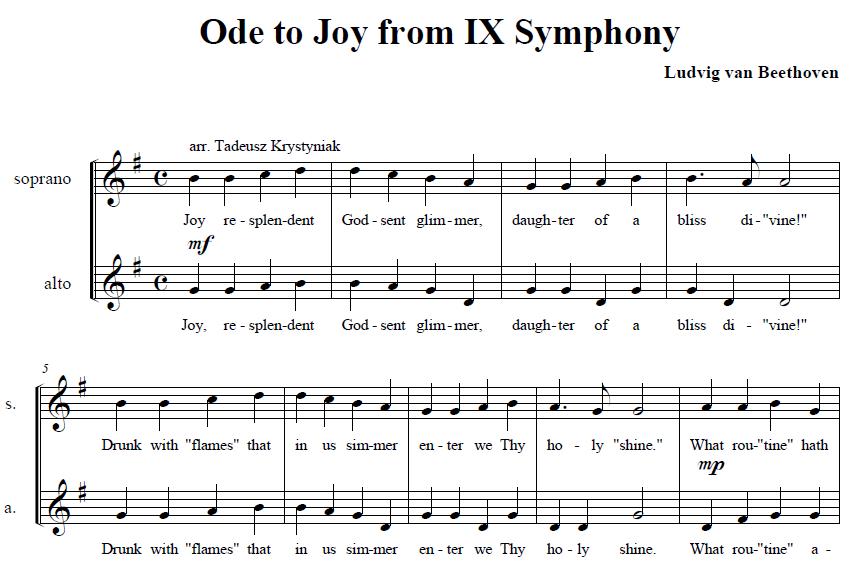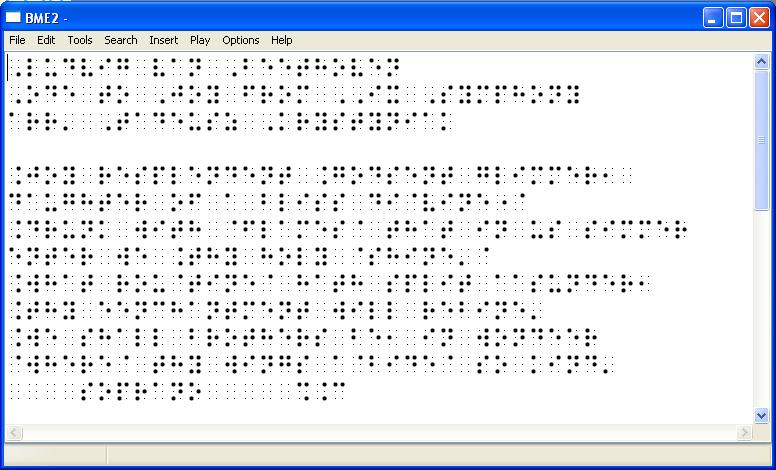Singing in voices is found to be a little bit more difficult than singing in unison. To start with, we will consider a song in two-voice arrangement. It is "Ode to Joy", the famous extract from IX Symphony by L. v. Beethoven.

For the purpose of our didactic unit we will adopt rather short, one-verse lyrics in English and the two-voice arrangement for two flutes by Tadeusz Krystyniak (see example).

The score consists of two parts: soprano and alto. The lyrics were inserted for each part separately, which was necessary because due to differences in rhythmic values in particular voices the lyrics for the soprano are not identical with those for the alto. This is a common phenomenon in multi-voice choral arrangements.
It is good to notice that BME makes it possible to select a different instrument for playing a particular voice. This is very helpful, making it easier for the listener to distinguish a required part from the whole.
An additional advantage is that apart from listening to the arrangement as a whole (in this case the two voices), we can listen to a single voice separately. In order to do it, you have to select "Set Midi Instruments" item in the "Play" menu (or use Ctrl+I shortcut) and check the part(s) which should be played, leaving the one(s) which is/are to be mute unchecked. It is also in this menu that you can assign a particular instrument to each part. It is advisable to choose the instruments contrasting in their timbre, such as the piano versus the organ, thus making a particular voice easy to identify for the listener.
And here is a suggested schedule of a lesson designed to teach the two-voice "Ode to Joy" to the class.
- The teacher presents the song to the class: if possible demonstrating a professional record of the famous piece first and then playing the two-voice arrangement from the BMML file.
- Using the Braille printouts the students get acquainted with the text. If needed, the teacher explains the meaning and corrects pronunciation (if English is not the native language).
- Considering the fact that "Ode to Joy" is a well-known tune, soprano's task will be easier. Soprano can sing the first 4 measures almost on the spot, with and without the computer accompaniment.
- Now the teacher reproduces the equivalent alto fragment from the file. The students sing it with the accompaniment, without it and finally, accompanied by the soprano.
- The teaching of the next 4-measure passage proceeds in the same way. The teacher indicates the measures which make the repetition of the first fragment. Thus the attention is paid more to the text.
- As soon as the second passage has been sung successfully, it is time to repeat the song from the beginning.
- Now we come to the fragment where the lyrics differ between the two voices. It requires more attention and more practice - alternately, each voice with the accompaniment or jointly with the other voice.
- As soon as the whole song can be performed in two voices, more attention should be paid to dynamics. Luckily, in this arrangement dynamics is rather scarce and the symbols should not be a great obstacle to reading notes. It happens, however, that abundant dynamic symbols in vocal music prove troublesome to a blind vocalist and slow down reading significantly. In such cases it would be desirable to have more than one version available so as to start work from the version free of details such as dynamics and accents and then to use richer scores later on. Braille Music Reader (BMR), which can be downloaded free of charge from the Music4vip website, allows one to hide elements, which is just what is needed here. While learning the singer can hide the elements he/she thinks to be burdensome at the moment and recover them later.
- Let us remember that having Braille scores gives the blind musician a chance to refresh the newly-learnt material at home and to feel comfortable at the next singing lesson or singing group rehearsal.
